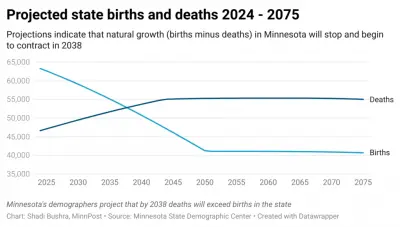Minnesota needs immigrants to propel population growth. How will federal policy affect that?

Minnesota’s population has grown in three ways: naturally via more births than deaths, people moving here from other states and international migration. Demographers point out, however, that in as few as four years, international migration will become the primary driver of the state’s population growth. And continued population growth will help address labor force shortages, increase the number of consumers and entrepreneurs, and broaden the state’s tax base. But these projections, which demographers have been watching for years, are taking place against a decidedly anti-immigration national backdrop. The Trump administration has blocked asylum access at the border, stopped issuing international student visas, tried to rescind temporary protected legal status for certain groups of immigrants, and banned travel to the U.S. for citizens from a dozen countries. Despite many of these issues being mired in legal challenges, taken together it sends a less-than-welcoming message to those who want to live, work, and study in the U.S. “The aging of the Baby Boomers has an impact on dampening growth, and at the same time, we have lower birth rates over time,” Minnesota’s state demographer, Susan Brower, told MinnPost. Susan Brower “We know that going forward, international immigration is going to continue to be an important source of population growth and actually become a more central component of growth in the future,” she said. The Trump administration’s immigration policies are so new that it’s difficult to anticipate how exactly they will show up in the state’s population data. But Brower walked me through the nature of Minnesota’s population growth in the past and what she and other demographers are projecting in the future. Those insights can help us understand what fewer immigrants coming to Minnesota might mean for the state. Natural growth, traditionally the main engine of Minnesota’s population increase, is slowing “Since the 1990s up until about 2020, Minnesota had been growing very rapidly, and much of that was due to our own internal growth,” Brower said. But that period of high natural growth appears close to peaking, with the state looking down the other side of a demographic mountain. !function(){"use strict";window.addEventListener("message",function(a){if(void 0!==a.data["datawrapper-height"]){var e=document.querySelectorAll("iframe");for(var t in a.data["datawrapper-height"])for(var r,i=0;r=e[i];i++)if(r.contentWindow===a.source){var d=a.data["datawrapper-height"][t]+"px";r.style.height=d}}})}(); “We’re projecting that Minnesota will not grow as rapidly as it has in the past because the population is aging. Older populations have fewer babies and they have higher mortality rates, and so it’s just much, much harder for an older population to grow compared to a younger population,” she said. At some point, Minnesota will no longer be able to maintain its current population, most recently estimated at 5.79 million in July of 2024, through natural growth alone. !function(){"use strict";window.addEventListener("message",function(a){if(void 0!==a.data["datawrapper-height"]){var e=document.querySelectorAll("iframe");for(var t in a.data["datawrapper-height"])for(var r,i=0;r=e[i];i++)if(r.contentWindow===a.source){var d=a.data["datawrapper-height"][t]+"px";r.style.height=d}}})}(); Historically, Minnesota saw more other Americans move to the state than leave it. That’s also changed. “In the 1990s we had a net inflow from other states,” Brower said. “What we’ve seen since the 2000s up until [now] is consistent, small but regular net outflows of people – mostly young people – to other states,” she said. There are many theories as to why young Minnesotans leave the state, but the general consensus is that this domestic out-migration has been more than offset by the international in-migration the state has seen. That leaves immigration as a source of population growth. How has that fared? Since 2020 immigration has propelled Minnesota’s population growth, and it is poised to do so into the foreseeable future. According to the Minnesota Chamber of Commerce, from 2020 to 2024, immigration made up 94% of the state’s net population growth. Needing immigration to prop up populations in the face of slowing birth rates and aging residents is a nationwide phenomenon, Brower said, but Midwestern states are hit sooner because they have slightly older populations and lower levels of immigration. “Compared to many other Midwestern states, Minnesota does OK, in part because we have, or have had, a healthy flow of immigrants from other countries that not all Midwestern states have experienced,” Brower said. This has been good for the state’s employers, making the Minnesota Chamber of Commerce – an advocacy group that promotes the interests of the business community – one of the biggest boosters of immigration to the state. Will that flow of immigrants continue for Minnesota? With immigration such a lynchpin of Minnesota’s growth, how will the state fare in this age of federal policies aimed at curbing immigration? Fifteen years ago, when she started this job, “I would have expected federal policies to eventually align with the demographic reality,” Brower said. “I would have expected them to adjust to the slower population growth. We haven’t seen that happen,” she said. Instead we’re in a world of labor force shortages caused by “dampened overall population growth,” Brower said. “We’re expecting to see that dampened growth continue, and that has implications for public budgets, for planning, and for economic growth potentially in the future.” !function(){"use strict";window.addEventListener("message",function(a){if(void 0!==a.data["datawrapper-height"]){var e=document.querySelectorAll("iframe");for(var t in a.data["datawrapper-height"])for(var r,i=0;r=e[i];i++)if(r.contentWindow===a.source){var d=a.data["datawrapper-height"][t]+"px";r.style.height=d}}})}(); What about native-born Minnesotans of different races? How do they factor in? Not all native-born Minnesotans are white, just as not all immigrants are people of color. Similar to how immigrants are driving population growth, non-white racial groups are also driving growth among the Minnesota-born population. This can be attributed in large part to the large proportion of young people in racial minorities compared to white Minnesotans. “Up to 35% of young people under the age of five are people of color. And when you get to the very oldest age groups, it’s in the single digits, 5% to 10% depending on which age group you’re looking at,” Brower said. “So part of what you’re going to see in terms of natural change is just a loss of the white population as there are more parents of color and fewer or the same number of white residents in their childbearing years,” she said. Wait, why do we need to grow Minnesota’s population? Immigration is economically advantageous for businesses because some immigrants bring specialized skills, some bring a willingness to do difficult jobs, and when the population grows, the market of consumers grows, as does the pool of workers. Related from Community Voices: What kind of immigration policy do we want for Minnesota’s economy? Much of our public sector and its decision-making processes similarly take future population growth as a given. “We build public budgets on the assumption of growth… and policies based on the fact that we will continue growing both at the local and the state levels. [Those assumptions] would need to change if we’re not going to have population growth at the same levels in the future,” Brower said. Other countries and states are struggling with declining or flat populations and are having difficulty adjusting their systems to accommodate a shrinking number of residents, she said. “It is about how things are funded, and also how our economy depends on ever-expanding markets and labor force growth – so far.” Policies failing to align with needs While there are issues that need to play out over time in the messy arena of politics, demographers like Brower see flashing warning lights in the labor market, particularly in industries where worker shortages can mean life or death. She highlighted the important role immigrants play in Minnesota’s health care industry, filling critical gaps in hospitals, long-term care homes, and in-home care services. “At least in specific areas, I would have expected federal policy to be more aligned with workforce needs than it is by now. But there has been such heightened concern around immigration, without understanding the demographic need for immigration,” Brower said. “Policies sometimes take a very long time to align, or maybe don’t align at all for a reason that isn’t necessarily logical demographically.” Will Trump’s immigration policies change course to meet labor needs? Until recently, the president seemed to have public support on this issue. Polls showed the most negative views of immigration were in the final months of former President Biden’s term. But that appears to have changed since Trump took office promising the largest mass deportation program in history. “After climbing to 55% in 2024, the percentage of Americans who say immigration should be reduced has dropped by nearly half to 30%,” Gallup said alongside its poll, released July 11, 2025. In fact, the most recent polling shows 79% of Americans think immigration is “a good thing” for the country, an increase from 64% a year ago and a high point in the nearly 25-year trend. While there’s no promise that this will translate into a different sort of immigration policy, it does offer a glimmer of hope for those who study population growth and decline, and who see immigration as a crucial part of Minnesota’s demographic and economic future. The post Minnesota needs immigrants to propel population growth. How will federal policy affect that? appeared first on MinnPost.


